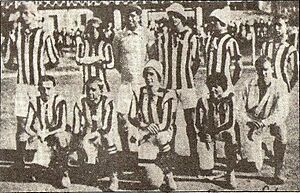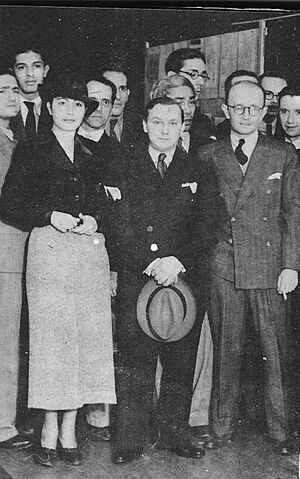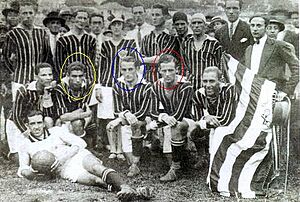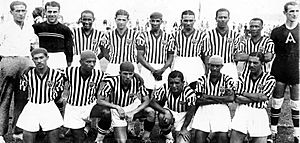History of Clube Atlético Mineiro facts for kids
Clube Atlético Mineiro, often called Atlético Mineiro or just Atlético, is a famous football club from Belo Horizonte, Brazil. Its amazing story began on March 25, 1908. Twenty-two students from Belo Horizonte started the team, led by Margival Mendes Leal and Mário Toledo.
Since 1915, Atlético has played in the Campeonato Mineiro, their state league. They have won this league a record 43 times! In 1937, they won their first national title, the Copa dos Campeões Estaduais. In 1950, Atlético went on a special trip called the European tour. This was a big deal for the club and for Brazilian football back then. During this tour, the team earned the nickname "The Ice Champions."
Since 1959, when national club competitions started in Brazil, Atlético has mostly played in the Campeonato Brasileiro Série A. This is the top football league in Brazil. They won this league once, in 1971, and finished second four times. In the 1970s, they also won the Copa dos Campeões Brasileiros in 1978.
Atlético started playing in international club competitions in 1972. Their first international title was the 1992 Copa CONMEBOL in 1992, which they won again in 1997. After some tough times in the 1990s, Atlético was moved down to a lower league in 2005 for the only time in their history. But they quickly returned to the top league in 2007. Since then, the club has won the Copa Libertadores in 2013, and both the Recopa Sudamericana and the Copa do Brasil in 2014. In 2021, Atlético won both national titles: the Campeonato Brasileiro and the Copa do Brasil. In 2022, they also won the Supercopa do Brasil against Flamengo.
Contents
How Atlético Mineiro Started (1908–1949)
Clube Atlético Mineiro was founded on March 25, 1908. Twenty-two students from Belo Horizonte started the club. Some of the founding players were Margival Mendes Leal, Mário Toledo, and Horácio Machado. Three other young men who were not at the first meeting are also seen as founders. The founders decided to name the club Athletico Mineiro Foot Ball Club.
Atlético's first game was against Sport Club Foot Ball. This was the biggest and oldest club in Belo Horizonte at that time. The game was played on March 21, 1909. Atlético won 3–0, and Aníbal Machado scored the first goal. Sport wanted a rematch the next week, and Atlético agreed. Atlético won again, this time 4–0. Even though the club was started by upper-class students, it welcomed players from all backgrounds. This made it known as a "people's club" in Belo Horizonte.
In 1913, the club officially changed its name to Clube Atlético Mineiro. The next year, in 1914, Atlético won its first championship, the Taça Bueno Brandão. This was the first competition ever held in the state of Minas Gerais. Atlético, América, and Yale played in it. In 1915, the club won the first Campeonato Mineiro. This is the state league of Minas Gerais.
América won the next ten Mineiro championships. Atlético won the league again in 1926, led by striker Mário de Castro. In 1927, forwards Said and Jairo joined Castro. They formed an attacking team called the Trio Maldito ("Unholy Trio"). This trio helped Atlético win another state league title. The team was coached by Jenő Medgyessy from Hungary. In 1929, the club played its first international game against Vitória de Setúbal. Atlético won 3–1 at the Presidente Antônio Carlos Stadium. This stadium had opened earlier that year and was the club's home for the next twenty years.
Castro was the first Atlético player to be called up to the Brazilian national team in 1929. But he said no because he was asked to be a reserve player. The Trio Maldito scored more than 450 goals for Atlético together.
Atlético won the state league in 1931 and 1932. Then, in 1933, they became a professional club. After winning the Campeonato Mineiro again in 1936, Atlético won its first national title in 1937. This was the 1937 Copa dos Campeões Estaduais. It was organized by the Federação Brasileira de Foot-Ball, a federation for professional clubs. This competition included state champions from Minas Gerais (Atlético), Rio de Janeiro (Fluminense), São Paulo (Portuguesa), and Espírito Santo (Rio Branco). Atlético beat Rio Branco 5–1 in the final game at the Antônio Carlos stadium. Key players for this win were Zezé Procópio, goalkeeper Kafunga, and Guará. After this, they won two more Campeonato Mineiro titles in 1938 and 1939.
Success continued in the 1940s with players like Bigode, Murilo Silva, Carlyle, Lucas Miranda, Nívio Gabrich, and Kafunga. The club was very strong in the state, winning the league in 1941, 1942, 1946, 1947, and 1949. While América had been Atlético's main rival, a new rivalry began with Cruzeiro in the 1940s. Cruzeiro became Galo's (Atlético's nickname) main challenger during this time.
European Tour and New Stadium (1950–1969)
In 1950, the club moved its home from Antônio Carlos to the newer and larger Estádio Independência. Atlético also won another Campeonato Mineiro title. This was also the year of the European tour. This was a very important event in the club's history. The team played friendly football matches in Europe. They were the first club from Minas Gerais and the first professional Brazilian club to play on that continent. Atlético Mineiro played ten matches from November 1 to December 7. They traveled through Germany, Austria, Belgium, Luxembourg, and France. The team won six matches, lost two, and tied two. They scored 24 goals and let in 18.
At that time, there were no regular national competitions in Brazil or continental ones in South America. After Brazil's tough loss in the 1950 World Cup final, Atlético's tour and its results were seen as a historic achievement for Brazilian football. Many of their wins happened in bad weather and snow.
When the team returned from the tour, they were honored by the Brazilian Sports Confederation. They received a standing ovation at the Maracanã before a game. Over 50,000 people welcomed them back to Belo Horizonte. This was called an "amazing" celebration in the city streets. Even though they didn't win every game, sports news praised Atlético Mineiro's tour as a big success for Brazilian football. Because of the results in snowy conditions, the team was nicknamed Campeões do Gelo (Portuguese for "Ice Champions"). This feat is even remembered in the club's official song.
The club continued its success in the state competition in the 1950s. They won five Campeonato Mineiro titles in a row from 1952 to 1956, and another in 1958. In 1959, Atlético played in the first Taça Brasil. This was a national cup competition for state league champions. It was created to choose Brazil's teams for the new Copa Libertadores. Between the 1940s and 1960s, important players for Atlético included Bigode, Carlyle, Nívio Gabrich, Murilo Silva, Lucas Miranda, Orlando Pingo de Ouro, Paulo Valentim, Mussula, Marcial de Mello, and Djalma Dias.
In the 1960s, Atlético won the Campeonato Mineiro twice, in 1962 and 1963. But they did not go far in the Taça Brasil. Mineirão, Belo Horizonte's new stadium, opened in 1965. It immediately became the club's home. In the mid-1960s, the rivalry with Cruzeiro became the biggest in the state. This happened after Cruzeiro won the first five state leagues played at the Mineirão. In 1967, another national competition was created, the Torneio Roberto Gomes Pedrosa. Atlético did not finish in the top four in any of its games in that decade. In the late 1960s, they had good friendly matches against national teams. In 1968, Atlético, playing as the Brazilian national team, beat European Championship runners-up Yugoslavia 3–2 at the Mineirão. The next year, the Seleção (Brazil's national team), which would win the 1970 FIFA World Cup, was beaten by Atlético 2–1.
National Success and State Dominance (1970–1989)
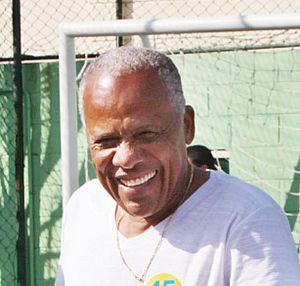
When Telê Santana became the club's manager in 1970, Atlético ended Cruzeiro's winning streak. They won their first state league title at the Mineirão. In 1971, led by midfielder Oldair and World Cup-winning forward Dadá Maravilha, the club won the Campeonato Brasileiro. This was the first time this competition, also known as the Brasileirão, was played. Atlético played a final group stage against São Paulo and Botafogo. They beat São Paulo 1–0 at the Mineirão and Botafogo 1–0 at the Maracanã. This win also meant the club played in its first official continental competition, the 1972 Copa Libertadores.
After four years without trophies, Atlético won the state league again in 1976. Starting in 1977, Atlético's youth program produced many great players. This group, which lasted until the mid-1980s, is seen as one of the best in the club's history. Reinaldo, Toninho Cerezo, Éder, Luisinho, Paulo Isidoro, and João Leite were key players. They helped Atlético win six state league titles in a row between 1978 and 1983. They also had good results in the Série A. Atlético finished second in the 1977 Brasileirão. They lost to São Paulo on penalties, even though they were undefeated all season. Reinaldo, the league's top scorer that season, was not allowed to play in the final. He said this was because he celebrated goals by raising his fist, which was a political symbol against the government at the time.
In 1978, Atlético reached the Copa Libertadores semi-finals. They also won the Copa dos Campeões Brasileiros. This was a tournament for past Brasileirão winners. Atlético beat São Paulo in a penalty shootout in the final. In 1980, Atlético lost in another controversial Brasileirão final. Three players were sent off against Flamengo, including Reinaldo. The next year, Atlético was eliminated from Copa Libertadores without losing a match. This happened after five players were sent off in a play-off match.
In that match, Atlético forward Reinaldo was given a red card for a foul on Flamengo's Zico. The referee then sent off Éder for complaining. The game stopped, and more Atlético players were sent off for arguing. With only seven players left, Atlético's goalkeeper João Leite pretended to be hurt. The referee refused to stop the game. An Atlético defender then held the ball, and he was also sent off. The game ended early because Atlético had less than seven players. The match was a 0–0 draw, which meant Flamengo moved on. Atlético tried to appeal, but it didn't work. This game and the referee's actions were called "shameful" by many.
During the 1980s, Atlético won international friendly competitions. The club had the best league records in the 1980, 1983, 1985, 1986, and 1987 Brasileirão seasons. But they did not win the title, losing in the finals or semi-finals. In the second half of the decade, the club continued to win in the state. They won the Campeonato Mineiro in 1985, 1986, 1988, and 1989. Atlético was one of Brazil's top teams in the 1980s. They sent many players to the Brazilian national team and played well in the Brasileirão. However, they often lost in the final knockout stages.
International Wins and Tough Times (1990–2009)
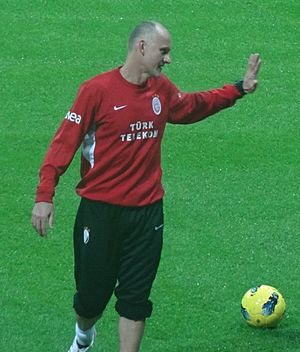
In the 1990s, Atlético won the state league in 1991. They also had international success in 1992. They won the first Copa CONMEBOL, their first official international title. They beat Olimpia in the finals. As champions, the club played in the 1993 Copa de Oro. They beat rivals Cruzeiro but lost to Boca Juniors. After finishing fourth in the 1994 Brasileirão, the next year they won the state league. They also reached the finals of the Copa CONMEBOL again, but lost to Rosario Central. In 1996, Atlético played in the Copa Masters CONMEBOL. This was a competition for past Copa CONMEBOL winners. Atlético beat Rosario Central but lost to São Paulo in the final. The team also finished third in the Brasileiro that year and fourth in the next year.
Another win came in the 1997 Copa CONMEBOL. An Atlético team with Marques and Cláudio Taffarel reached the finals. Atlético faced an Argentine team, Lanús, for the third time in a continental final. Atlético won the first game 4–1. After the match, Atlético players and staff were attacked by Lanús players and fans. Atlético coach Emerson Leão needed surgery after being hit. The second game was played at the Mineirão. Atlético secured the win with a 1–1 draw, winning their second international title without losing a game. Atlético player Valdir was the top scorer with seven goals.
In 1999, after another Campeonato Mineiro title, an Atlético team led by Marques and Guilherme reached the Série A finals. But they lost to Corinthians. Even with international success, this decade was tough for the club's money situation.
Atlético won the Campeonato Mineiro in 2000. They reached the Copa Libertadores quarter-finals and the semi-finals of Copa Mercosur. But they had a bad season in the national league. The next season, even with good players like Marques, Guilherme, and Gilberto Silva, the team was again eliminated in the Série A semi-finals. They finished fourth. Atlético then finished in the upper part of the national league table for two seasons. But in 2004, they almost moved down to a lower league. In 2005, the club was moved to the Série B, the second level of the Brasileirão.
The club was promoted right back up as Série B champion in 2006. They returned to the Série A for the 2007 season. That year, Atlético won the Campeonato Mineiro, their first trophy in seven years. They finished eighth in the national league. Alexandre Kalil became the club's new president in 2008. He tried to improve the club's money and standing. In 2009, with Diego Tardelli playing well, Atlético led the Brasileirão for eight weeks. They eventually finished seventh. The 2000s were not a very successful time for the club.
National Comeback and International Glory (2010–Present)
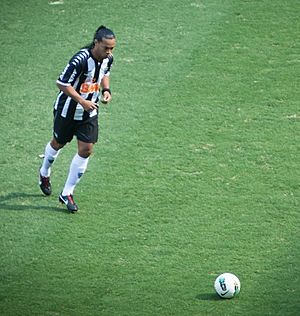
The team won its 40th Campeonato Mineiro in 2010. But they finished 13th in the Série A. After a tough year in 2011, a new successful time began when Cuca became manager at the end of that season. In 2012, the club moved back to the Independência stadium. They won the Campeonato Mineiro without losing a game. Ronaldinho joining the team in the middle of the season was a big event. The club finished second in the Série A and earned a spot in the next year's Copa Libertadores.
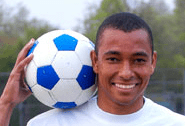
In 2013, Tardelli returned to the club. He joined Ronaldinho, Jô, and Bernard. Atlético had another strong start, winning the Campeonato Mineiro again. They also qualified for the knockout stages of the Libertadores as the best team. A memorable moment happened at the Independência stadium. This stadium had been Atlético's home since 2012. In the second game of the Libertadores quarter-finals against Tijuana, the score was 1–1. In the 87th minute, a penalty was given against Atlético. Goalkeeper Victor saved it with his foot! Many people felt this save ended the club's historic bad luck.
In the semi-finals, Atlético faced Argentine champions Newell's Old Boys. They lost the first game 2–0. In the second game, Atlético scored in the first half. After a power outage stopped the match, they scored again in the 96th minute, making it 2–0. Atlético won 3–2 on penalties. In the finals, Atlético played Olimpia again. Atlético lost the first game 2–0. The second game was played at the Mineirão. A goal by Jô and a header by Leonardo Silva in the 87th minute tied the score. The game went to extra time and then to a penalty shootout. Atlético Mineiro won 4–3 to claim its first Copa Libertadores title! Jô was the top goal scorer with seven goals, and Victor was chosen as the best goalkeeper. However, the club's first time in the FIFA Club World Cup was not successful. They lost to Raja Casablanca and finished third.
The next year, Atlético won its first Recopa Sudamericana. They played Lanús again in a continental final. Atlético won the first game 1–0. In the second game, Diego Tardelli scored his 100th goal for the club. Atlético won 4–3 after extra time.
In that season's Copa do Brasil quarter-finals against Corinthians and semi-finals against Flamengo, Atlético lost the first game 2–0. But they made amazing comebacks, winning 4–1 in both stages to move on. Atlético won its first Copa do Brasil by beating rivals Cruzeiro twice in the finals. This was the first national final between the two Belo Horizonte clubs. At the end of 2014, Alexandre Kalil's time as president ended. Daniel Nepomuceno was elected. The team's successful run continued with its 43rd state league win in 2015. Nepomuceno announced that Atlético had a plan to build a new stadium in Belo Horizonte with a capacity for 45,000 people.
Images for kids
-
Ronaldinho played an important part in the club's comeback after he joined in 2012
See also
- List of Clube Atlético Mineiro seasons


